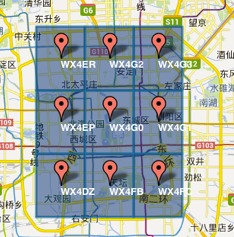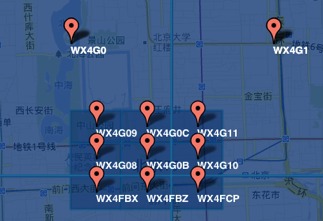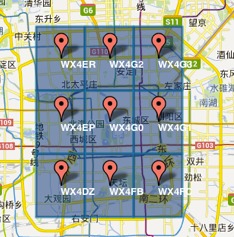GeoHash算法:将二维的点数据转换成一维的数据
1、Geohash的最简单的解释就是:将一个经纬度信息,转换成一个可以排序,可以比较的字符串编码。
2、geohash有以下几个特点:
Geohash比直接用经纬度的高效很多。
3、编码方式:
首先将纬度范围(-90, 90)平分成两个区间(-90,0)、(0, 90),如果目标纬度位于前一个区间,则编码为0,否则编码为1。由于39.92324属于(0, 90),所以取编码为1。
然后再将(0, 90)分成 (0, 45), (45, 90)两个区间,而39.92324位于(0, 45),所以编码为0。
以此类推,直到精度符合要求为止,得到纬度编码为1011 1000 1100 0111 1001。
经度也用同样的算法,对(-180, 180)依次细分,得到116.3906的编码为1101 0010 1100 0100 0100。
解码算法与编码算法相反,先进行base32解码,然后分离出经纬度,最后根据二进制编码对经纬度范围进行细分即可,这里不再赘述。
PHP实现方式:
4、感性认识:
1)GeoHash将二维的经纬度转换成字符串,比如下图展示了北京9个区域的GeoHash字符串,分别是WX4ER,WX4G2、WX4G3等等,每一个字符串代表了某一矩形区域。也就是说,这个矩形区域内所有的点(经纬度坐标)都共享相同的GeoHash字符串,这样既可以保护隐私(只表示大概区域位置而不是具体的点),又比较容易做缓存,比如左上角这个区域内的用户不断发送位置信息请求餐馆数据,由于这些用户的GeoHash字符串都是WX4ER,所以可以把WX4ER当作key,把该区域的餐馆信息当作value来进行缓存,而如果不使用GeoHash的话,由于区域内的用户传来的经纬度是各不相同的,很难做缓存。
2)字符串越长,表示的范围越精确。如图所示,5位的编码能表示10平方千米范围的矩形区域,而6位编码能表示更精细的区域(约0.34平方千米)
3)字符串相似的表示距离相近(特殊情况后文阐述),这样可以利用字符串的前缀匹配来查询附近的POI信息。如下两个图所示,一个在城区,一个在郊区,城区的GeoHash字符串之间比较相似,郊区的字符串之间也比较相似,而城区和郊区的GeoHash字符串相似程度要低些。
通过上面的介绍我们知道了GeoHash就是一种将经纬度转换成字符串的方法,并且使得在大部分情况下,字符串前缀匹配越多的距离越近,回到我们的案例,根据所在位置查询来查询附近餐馆时,只需要将所在位置经纬度转换成GeoHash字符串,并与各个餐馆的GeoHash字符串进行前缀匹配,匹配越多的距离越近。
5、使用注意点:
1)由于GeoHash是将区域划分为一个个规则矩形,并对每个矩形进行编码,这样在查询附近POI信息时会导致以下问题,比如红色的点是我们的位置,绿色的两个点分别是附近的两个餐馆,但是在查询的时候会发现距离较远餐馆的GeoHash编码与我们一样(因为在同一个GeoHash区域块上),而较近餐馆的GeoHash编码与我们不一致。这个问题往往产生在边界处。
解决的思路很简单,我们查询时,除了使用定位点的GeoHash编码进行匹配外,还使用周围8个区域的GeoHash编码,这样可以避免这个问题。
2)我们已经知道现有的GeoHash算法使用的是Peano空间填充曲线,这种曲线会产生突变,造成了编码虽然相似但距离可能相差很大的问题,因此在查询附近餐馆时候,首先筛选GeoHash编码相似的POI点,然后进行实际距离计算。
学习参考文档:http://www.cnblogs.com/dengxinglin/archive/2012/12/14/2817761.html
http://blog.jobbole.com/80633/
2、geohash有以下几个特点:
- 首先,geohash用一个字符串表示经度和纬度两个坐标。某些情况下无法在两列上同时应用索引 (例如MySQL 4之前的版本,Google App Engine的数据层等),利用geohash,只需在一列上应用索引即可。
- 其次,geohash表示的并不是一个点,而是一个矩形区域。比如编码wx4g0ec19,它表示的是一个矩形区域。 使用者可以发布地址编码,既能表明自己位于北海公园附近,又不至于暴露自己的精确坐标,有助于隐私保护。
- 第三,编码的前缀可以表示更大的区域。例如wx4g0ec1,它的前缀wx4g0e表示包含编码wx4g0ec1在内的更大范围。 这个特性可以用于附近地点搜索。首先根据用户当前坐标计算geohash(例如wx4g0ec1)然后取其前缀进行查询 (SELECT * FROM place WHERE geohash LIKE 'wx4g0e%'),即可查询附近的所有地点。
Geohash比直接用经纬度的高效很多。
3、编码方式:
首先将纬度范围(-90, 90)平分成两个区间(-90,0)、(0, 90),如果目标纬度位于前一个区间,则编码为0,否则编码为1。由于39.92324属于(0, 90),所以取编码为1。
然后再将(0, 90)分成 (0, 45), (45, 90)两个区间,而39.92324位于(0, 45),所以编码为0。
以此类推,直到精度符合要求为止,得到纬度编码为1011 1000 1100 0111 1001。
经度也用同样的算法,对(-180, 180)依次细分,得到116.3906的编码为1101 0010 1100 0100 0100。
解码算法与编码算法相反,先进行base32解码,然后分离出经纬度,最后根据二进制编码对经纬度范围进行细分即可,这里不再赘述。
PHP实现方式:
<?php
/**
* Geohash generation class
* http://blog.dixo.net/downloads/
*
* This file copyright (C) 2008 Paul Dixon (paul@elphin.com)
*
* This program is free software; you can redistribute it and/or
* modify it under the terms of the GNU General Public License
* as published by the Free Software Foundation; either version 3
* of the License, or (at your option) any later version.
*
* This program is distributed in the hope that it will be useful,
* but WITHOUT ANY WARRANTY; without even the implied warranty of
* MERCHANTABILITY or FITNESS FOR A PARTICULAR PURPOSE. See the
* GNU General Public License for more details.
*
* You should have received a copy of the GNU General Public License
* along with this program; if not, write to the Free Software
* Foundation, Inc., 59 Temple Place - Suite 330, Boston, MA 02111-1307, USA.
*/
/**
* Encode and decode geohashes
*
*/
class Geohash
{
private $coding="0123456789bcdefghjkmnpqrstuvwxyz";
private $codingMap=array();
public function Geohash()
{
//build map from encoding char to 0 padded bitfield
for($i=0; $i<32; $i++)
{
$this->codingMap[substr($this->coding,$i,1)]=str_pad(decbin($i), 5, "0", STR_PAD_LEFT);
}
}
/**
* Decode a geohash and return an array with decimal lat,long in it
*/
public function decode($hash)
{
//decode hash into binary string
$binary="";
$hl=strlen($hash);
for($i=0; $i<$hl; $i++)
{
$binary.=$this->codingMap[substr($hash,$i,1)];
}
//split the binary into lat and log binary strings
$bl=strlen($binary);
$blat="";
$blong="";
for ($i=0; $i<$bl; $i++)
{
if ($i%2)
$blat=$blat.substr($binary,$i,1);
else
$blong=$blong.substr($binary,$i,1);
}
//now concert to decimal
$lat=$this->binDecode($blat,-90,90);
$long=$this->binDecode($blong,-180,180);
//figure out how precise the bit count makes this calculation
$latErr=$this->calcError(strlen($blat),-90,90);
$longErr=$this->calcError(strlen($blong),-180,180);
//how many decimal places should we use? There's a little art to
//this to ensure I get the same roundings as geohash.org
$latPlaces=max(1, -round(log10($latErr))) - 1;
$longPlaces=max(1, -round(log10($longErr))) - 1;
//round it
$lat=round($lat, $latPlaces);
$long=round($long, $longPlaces);
return array($lat,$long);
}
/**
* Encode a hash from given lat and long
*/
public function encode($lat,$long)
{
//how many bits does latitude need?
$plat=$this->precision($lat);
$latbits=1;
$err=45;
while($err>$plat)
{
$latbits++;
$err/=2;
}
//how many bits does longitude need?
$plong=$this->precision($long);
$longbits=1;
$err=90;
while($err>$plong)
{
$longbits++;
$err/=2;
}
//bit counts need to be equal
$bits=max($latbits,$longbits);
//as the hash create bits in groups of 5, lets not
//waste any bits - lets bulk it up to a multiple of 5
//and favour the longitude for any odd bits
$longbits=$bits;
$latbits=$bits;
$addlong=1;
while (($longbits+$latbits)%5 != 0)
{
$longbits+=$addlong;
$latbits+=!$addlong;
$addlong=!$addlong;
}
//encode each as binary string
$blat=$this->binEncode($lat,-90,90, $latbits);
$blong=$this->binEncode($long,-180,180,$longbits);
//merge lat and long together
$binary="";
$uselong=1;
while (strlen($blat)+strlen($blong))
{
if ($uselong)
{
$binary=$binary.substr($blong,0,1);
$blong=substr($blong,1);
}
else
{
$binary=$binary.substr($blat,0,1);
$blat=substr($blat,1);
}
$uselong=!$uselong;
}
//convert binary string to hash
$hash="";
for ($i=0; $i<strlen($binary); $i+=5)
{
$n=bindec(substr($binary,$i,5));
$hash=$hash.$this->coding[$n];
}
return $hash;
}
/**
* What's the maximum error for $bits bits covering a range $min to $max
*/
private function calcError($bits,$min,$max)
{
$err=($max-$min)/2;
while ($bits--)
$err/=2;
return $err;
}
/*
* returns precision of number
* precision of 42 is 0.5
* precision of 42.4 is 0.05
* precision of 42.41 is 0.005 etc
*/
private function precision($number)
{
$precision=0;
$pt=strpos($number,'.');
if ($pt!==false)
{
$precision=-(strlen($number)-$pt-1);
}
return pow(10,$precision)/2;
}
/**
* create binary encoding of number as detailed in http://en.wikipedia.org/wiki/Geohash#Example
* removing the tail recursion is left an exercise for the reader
*/
private function binEncode($number, $min, $max, $bitcount)
{
if ($bitcount==0)
return "";
#echo "$bitcount: $min $max<br>";
//this is our mid point - we will produce a bit to say
//whether $number is above or below this mid point
$mid=($min+$max)/2;
if ($number>$mid)
return "1".$this->binEncode($number, $mid, $max,$bitcount-1);
else
return "0".$this->binEncode($number, $min, $mid,$bitcount-1);
}
/**
* decodes binary encoding of number as detailed in http://en.wikipedia.org/wiki/Geohash#Example
* removing the tail recursion is left an exercise for the reader
*/
private function binDecode($binary, $min, $max)
{
$mid=($min+$max)/2;
if (strlen($binary)==0)
return $mid;
$bit=substr($binary,0,1);
$binary=substr($binary,1);
if ($bit==1)
return $this->binDecode($binary, $mid, $max);
else
return $this->binDecode($binary, $min, $mid);
}
}
?>
4、感性认识:
1)GeoHash将二维的经纬度转换成字符串,比如下图展示了北京9个区域的GeoHash字符串,分别是WX4ER,WX4G2、WX4G3等等,每一个字符串代表了某一矩形区域。也就是说,这个矩形区域内所有的点(经纬度坐标)都共享相同的GeoHash字符串,这样既可以保护隐私(只表示大概区域位置而不是具体的点),又比较容易做缓存,比如左上角这个区域内的用户不断发送位置信息请求餐馆数据,由于这些用户的GeoHash字符串都是WX4ER,所以可以把WX4ER当作key,把该区域的餐馆信息当作value来进行缓存,而如果不使用GeoHash的话,由于区域内的用户传来的经纬度是各不相同的,很难做缓存。
2)字符串越长,表示的范围越精确。如图所示,5位的编码能表示10平方千米范围的矩形区域,而6位编码能表示更精细的区域(约0.34平方千米)
3)字符串相似的表示距离相近(特殊情况后文阐述),这样可以利用字符串的前缀匹配来查询附近的POI信息。如下两个图所示,一个在城区,一个在郊区,城区的GeoHash字符串之间比较相似,郊区的字符串之间也比较相似,而城区和郊区的GeoHash字符串相似程度要低些。
通过上面的介绍我们知道了GeoHash就是一种将经纬度转换成字符串的方法,并且使得在大部分情况下,字符串前缀匹配越多的距离越近,回到我们的案例,根据所在位置查询来查询附近餐馆时,只需要将所在位置经纬度转换成GeoHash字符串,并与各个餐馆的GeoHash字符串进行前缀匹配,匹配越多的距离越近。
5、使用注意点:
1)由于GeoHash是将区域划分为一个个规则矩形,并对每个矩形进行编码,这样在查询附近POI信息时会导致以下问题,比如红色的点是我们的位置,绿色的两个点分别是附近的两个餐馆,但是在查询的时候会发现距离较远餐馆的GeoHash编码与我们一样(因为在同一个GeoHash区域块上),而较近餐馆的GeoHash编码与我们不一致。这个问题往往产生在边界处。
解决的思路很简单,我们查询时,除了使用定位点的GeoHash编码进行匹配外,还使用周围8个区域的GeoHash编码,这样可以避免这个问题。
2)我们已经知道现有的GeoHash算法使用的是Peano空间填充曲线,这种曲线会产生突变,造成了编码虽然相似但距离可能相差很大的问题,因此在查询附近餐馆时候,首先筛选GeoHash编码相似的POI点,然后进行实际距离计算。
学习参考文档:http://www.cnblogs.com/dengxinglin/archive/2012/12/14/2817761.html
http://blog.jobbole.com/80633/







